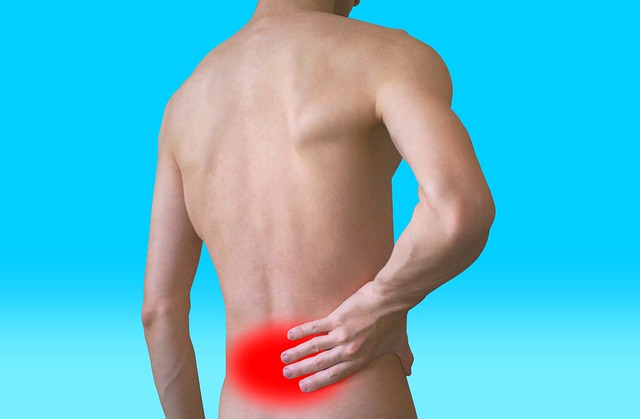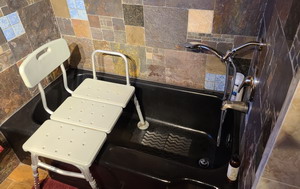 I was bending over the tub this morning preparing to give Ellen her bath when I noticed a tender soreness across my low back on both sides. Now I don’t normally have back pain, so I pay immediate attention to any pain signals I get. I learned to do this the hard way. Several years ago I was remodeling my kitchen on the cheap. I had removed all the cupboard doors and decided to sand them down and refinish them. This entailed many hours of work bent-forward using a palm sander on the doors. After about five hours, my back was feeling tired and sore. The smart move would have been to stop, rest, and finish the last few doors the next day. But I only had three doors left to go and really wanted to finish them all that day. Well, I pressed on and in about a half an hour my back seized up.I ended up stuck in bed for a week. With what I lost in work time, I could have bought all new doors.
I was bending over the tub this morning preparing to give Ellen her bath when I noticed a tender soreness across my low back on both sides. Now I don’t normally have back pain, so I pay immediate attention to any pain signals I get. I learned to do this the hard way. Several years ago I was remodeling my kitchen on the cheap. I had removed all the cupboard doors and decided to sand them down and refinish them. This entailed many hours of work bent-forward using a palm sander on the doors. After about five hours, my back was feeling tired and sore. The smart move would have been to stop, rest, and finish the last few doors the next day. But I only had three doors left to go and really wanted to finish them all that day. Well, I pressed on and in about a half an hour my back seized up.I ended up stuck in bed for a week. With what I lost in work time, I could have bought all new doors.
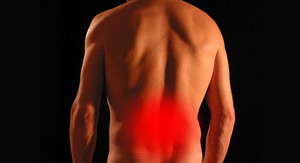 Since that lovely experience, I pay attention when my back tells me it is sore or otherwise not happy. I have a bit of experience diagnosing the causes of back pain, so that is what I did right there in the bathroom. I straightened up carefully and checked the most likely cause of back pain on both sides — the psoas muscles. These are the muscles that travel from your low back on both sides down to your groin where your leg attaches in the front. You use these muscles to lift your leg while walking or climbing. Sure enough, both groin attachments were tender. I had not done anything that would have overworked these muscles in the last two days, so I then checked for the most common cause of tight psoas muscles besides overwork — an irritated colon. Specifically, I checked for tenderness over the ileo-cecal valve and the valve of Houston. These spots are just inward an inch toward the belly button from the part of the pelvis bone that sticks out on either side of the hips. Sure enough, both of these were tender. These valves lay right on top of the psoas muscles, and when they get inflamed, the psoas tightens up which pulls the low back forward.
Since that lovely experience, I pay attention when my back tells me it is sore or otherwise not happy. I have a bit of experience diagnosing the causes of back pain, so that is what I did right there in the bathroom. I straightened up carefully and checked the most likely cause of back pain on both sides — the psoas muscles. These are the muscles that travel from your low back on both sides down to your groin where your leg attaches in the front. You use these muscles to lift your leg while walking or climbing. Sure enough, both groin attachments were tender. I had not done anything that would have overworked these muscles in the last two days, so I then checked for the most common cause of tight psoas muscles besides overwork — an irritated colon. Specifically, I checked for tenderness over the ileo-cecal valve and the valve of Houston. These spots are just inward an inch toward the belly button from the part of the pelvis bone that sticks out on either side of the hips. Sure enough, both of these were tender. These valves lay right on top of the psoas muscles, and when they get inflamed, the psoas tightens up which pulls the low back forward.
 I had eaten some macadamia nuts the evening before, and most likely they had triggered some gut inflammation. Even though the date on the bag indicated that they were fresh, my nose occasionally detected a touch of rancidity. Rancid oils really play havoc on the gut. This morning that gut distress was expressing itself as low back pain. If I ignored this, I was running the risk of actually pinching the low back with some simple movement while the joints were compromised by being pulled forward by the psoas muscles. That would likely cause me quite a bit of unnecessary pain, so I walked into the bedroom, pulled out my spare Activator adjuster tool, and adjusted my valves, psoas muscles, and my low back as well for good measure. That relieved the back pain.
I had eaten some macadamia nuts the evening before, and most likely they had triggered some gut inflammation. Even though the date on the bag indicated that they were fresh, my nose occasionally detected a touch of rancidity. Rancid oils really play havoc on the gut. This morning that gut distress was expressing itself as low back pain. If I ignored this, I was running the risk of actually pinching the low back with some simple movement while the joints were compromised by being pulled forward by the psoas muscles. That would likely cause me quite a bit of unnecessary pain, so I walked into the bedroom, pulled out my spare Activator adjuster tool, and adjusted my valves, psoas muscles, and my low back as well for good measure. That relieved the back pain.
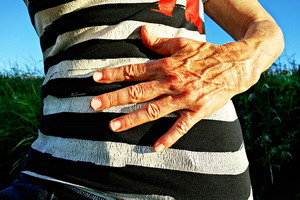 Most of you do not have spare Activator adjusting tools at home to correct such issues easily, but you can still resolve these yourself without a visit to your chiropractor. The first step is to calm down the valves. Do this first by deeply massaging over the valves while lightly holding the skin over one valve with one hand, as you stretch any long muscle you can reach with the other hand. Hold this pose for a good three minutes. This is called a Bennett Reflex and it opens up the blood flow around the spastic valve to enable it to relax. Once this has been done, go for the tender points in each groin. If the psoas muscle is too tight, you want to press upward on the tender groin point pointing towards the low back and push several times to relax the muscle. Here you are stimulating special nerve endings in the muscle attachment called Golgi tendon bodies. If you do this correctly, the back pain should relax along with the psoas muscles. Lastly, do some very gentle stretching of the low back in every direction to encourage the low back joints to settle back into their normal position. If there is still some tenderness, you may need a round of heat and cold on the low back — 15 minutes of heat followed by 15 minutes of refrigerator cold.
Most of you do not have spare Activator adjusting tools at home to correct such issues easily, but you can still resolve these yourself without a visit to your chiropractor. The first step is to calm down the valves. Do this first by deeply massaging over the valves while lightly holding the skin over one valve with one hand, as you stretch any long muscle you can reach with the other hand. Hold this pose for a good three minutes. This is called a Bennett Reflex and it opens up the blood flow around the spastic valve to enable it to relax. Once this has been done, go for the tender points in each groin. If the psoas muscle is too tight, you want to press upward on the tender groin point pointing towards the low back and push several times to relax the muscle. Here you are stimulating special nerve endings in the muscle attachment called Golgi tendon bodies. If you do this correctly, the back pain should relax along with the psoas muscles. Lastly, do some very gentle stretching of the low back in every direction to encourage the low back joints to settle back into their normal position. If there is still some tenderness, you may need a round of heat and cold on the low back — 15 minutes of heat followed by 15 minutes of refrigerator cold.
 This was an example of the most common low back pain pattern I see in the office. The second most common type is one-sided low back pain that extends into the hip and sometimes down the leg. Sometimes these can be handled at home and sometimes not. The pattern is similar to the double-sided low back pain. Check the same stuff on just the painful side. One-sided patterns are usually from overdoing some activity. If this has caused too much tension in just one of the psoas muscles due to too much of a one-sided activity like raking leaves or vacuuming, the tight muscle will pinch one side of the low back vertebra causing joint capsule swelling and nerve irritation. The psoas release and heat and cold will often correct these issues. Sometimes, however, particularly if any heavy lifting is involved, you may get an actual strain in the tiny ligaments of the sacroiliac joint, and the joint may slip down on one side. There is no at-home fix for this, so get on the phone and get an appointment to reset this. This is usually a two-visit correction in my experience.
This was an example of the most common low back pain pattern I see in the office. The second most common type is one-sided low back pain that extends into the hip and sometimes down the leg. Sometimes these can be handled at home and sometimes not. The pattern is similar to the double-sided low back pain. Check the same stuff on just the painful side. One-sided patterns are usually from overdoing some activity. If this has caused too much tension in just one of the psoas muscles due to too much of a one-sided activity like raking leaves or vacuuming, the tight muscle will pinch one side of the low back vertebra causing joint capsule swelling and nerve irritation. The psoas release and heat and cold will often correct these issues. Sometimes, however, particularly if any heavy lifting is involved, you may get an actual strain in the tiny ligaments of the sacroiliac joint, and the joint may slip down on one side. There is no at-home fix for this, so get on the phone and get an appointment to reset this. This is usually a two-visit correction in my experience.
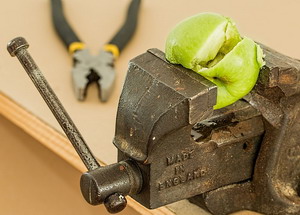 The third most common low-back pattern I see is compression. There are several flavors of this pattern relating to the severity of the underlying cause. Between the vertebra in your low back are cushions called discs. They are soft and squishy to allow many directions of movement between the vertebra. Compare this type of joint to an elbow, finger, or knee. These joints have hard surfaces that slide in one direction only yet are still strong and stable. Vertebral joints can move forward, backward, right, left, twist, and tilt a small amount. Their stability comes from the seven layers of control muscles surrounding each joint. Any one of these muscles might get tired or confused or inflamed for a variety of reasons, the most common being a simple lack of movement. As long as you are upright, all these muscles are tight in varying amounts. They need movement to push blood flow through them to remove metabolic wastes and bring in nutrition. Guess what does not happen when you simply sit at a desk all day?
The third most common low-back pattern I see is compression. There are several flavors of this pattern relating to the severity of the underlying cause. Between the vertebra in your low back are cushions called discs. They are soft and squishy to allow many directions of movement between the vertebra. Compare this type of joint to an elbow, finger, or knee. These joints have hard surfaces that slide in one direction only yet are still strong and stable. Vertebral joints can move forward, backward, right, left, twist, and tilt a small amount. Their stability comes from the seven layers of control muscles surrounding each joint. Any one of these muscles might get tired or confused or inflamed for a variety of reasons, the most common being a simple lack of movement. As long as you are upright, all these muscles are tight in varying amounts. They need movement to push blood flow through them to remove metabolic wastes and bring in nutrition. Guess what does not happen when you simply sit at a desk all day?
 The third most common low back problem I see I call sitting disease. We are not designed to sit still for more than 20 to 30 minutes at a time. More than that compromises the muscle integrity and joint function in your low back. But these are tiny compromises that build up over time. It shows up as chronic inflammation which causes degeneration of the squishy discs. Inflammation attracts calcium ions to the area which clogs up the pores in the discs causing them to dry out and get thinner and stiffer. As this happens the joints start to pinch together causing pain. In this state of instability, seemingly insignificant movements or actions will trigger a spasm of these stabilizing muscles creating the pain that prompts the patient to seek care.
The third most common low back problem I see I call sitting disease. We are not designed to sit still for more than 20 to 30 minutes at a time. More than that compromises the muscle integrity and joint function in your low back. But these are tiny compromises that build up over time. It shows up as chronic inflammation which causes degeneration of the squishy discs. Inflammation attracts calcium ions to the area which clogs up the pores in the discs causing them to dry out and get thinner and stiffer. As this happens the joints start to pinch together causing pain. In this state of instability, seemingly insignificant movements or actions will trigger a spasm of these stabilizing muscles creating the pain that prompts the patient to seek care.
 This gradual degeneration of the low back discs and joints takes place slowly over 20 to 40 years. That is why most of my patients with this pain pattern are in their 40s to 60s. This unfortunate chain of events can be prevented by attending to the vital self-care of your spine. Movement is one key. If you are sitting for more than half an hour, get up and stretch and move for 30 seconds every half hour. Remember those pesky psoas muscles from the first type of common low back pain? When you sit, those muscles are shortened to their max. When they stay short for long periods of time, they lock in that position. You don’t notice this while you are sitting, but when you go to get up, you have difficulty standing up fully straight for several steps. During those few steps, your low back vertebra is being jammed forward by the tight psoas muscles, pinching the joint capsules and causing damage. We have special muscles that are supposed to prevent this from happening called the multifidi muscles. These are stabilizer muscles that hold joints steady while we move. Normal exercises do not help them, but we need them to be really strong to counter the effects of sitting. There are special exercises called Foundation exercises we can do to protect and improve our backs. Check them out here.
This gradual degeneration of the low back discs and joints takes place slowly over 20 to 40 years. That is why most of my patients with this pain pattern are in their 40s to 60s. This unfortunate chain of events can be prevented by attending to the vital self-care of your spine. Movement is one key. If you are sitting for more than half an hour, get up and stretch and move for 30 seconds every half hour. Remember those pesky psoas muscles from the first type of common low back pain? When you sit, those muscles are shortened to their max. When they stay short for long periods of time, they lock in that position. You don’t notice this while you are sitting, but when you go to get up, you have difficulty standing up fully straight for several steps. During those few steps, your low back vertebra is being jammed forward by the tight psoas muscles, pinching the joint capsules and causing damage. We have special muscles that are supposed to prevent this from happening called the multifidi muscles. These are stabilizer muscles that hold joints steady while we move. Normal exercises do not help them, but we need them to be really strong to counter the effects of sitting. There are special exercises called Foundation exercises we can do to protect and improve our backs. Check them out here.
 If you are in pain from this third type of common low back issue your best bet is to use heat and cold as described before, rest in a recliner or laying down, and try regular gentle walking movements as tolerated. Recovery time from this pattern depends on how progressed the damage is in the discs. In the office, I can unlock the spasm and increase the spacing between the vertebra with a disc pump device. My experience is that patients are typically better within 24 – 36 hours. I would expect that simple cases at home should respond in about the same amount of time if you are successful at getting the spasm released. Magnesium is Mother Nature’s muscle relaxant, so I would take 400 to 600 mg of this as well or even take a nice Epsom salt bath. Epsom salts are magnesium salts that help relax muscle spasms through the skin.
If you are in pain from this third type of common low back issue your best bet is to use heat and cold as described before, rest in a recliner or laying down, and try regular gentle walking movements as tolerated. Recovery time from this pattern depends on how progressed the damage is in the discs. In the office, I can unlock the spasm and increase the spacing between the vertebra with a disc pump device. My experience is that patients are typically better within 24 – 36 hours. I would expect that simple cases at home should respond in about the same amount of time if you are successful at getting the spasm released. Magnesium is Mother Nature’s muscle relaxant, so I would take 400 to 600 mg of this as well or even take a nice Epsom salt bath. Epsom salts are magnesium salts that help relax muscle spasms through the skin.
 These three low back patterns account for about 85% of the reasons I see low back pain in my patients. Treatment moves recovery along faster, but you are not always able to get in for treatment. Hopefully, this article will help you to diagnose your own condition and initiate treatment yourself at home.
These three low back patterns account for about 85% of the reasons I see low back pain in my patients. Treatment moves recovery along faster, but you are not always able to get in for treatment. Hopefully, this article will help you to diagnose your own condition and initiate treatment yourself at home.
Take care,
David
